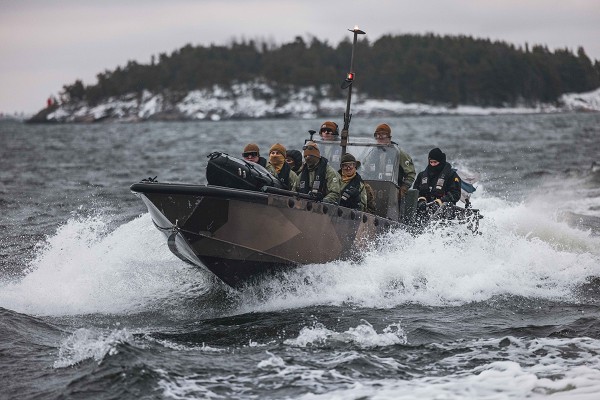 Baltic Sea. (November 25, 2022): In this photo by Corporal Jackson Kirkiewicz, U. S. Marines with Combat Logistical Battalion, 2nd Marines Logistics Group drive a Finnish G-Class landing craft while operating the “Amy”, an unmanned surface vehicle on the Baltic Sea off the coast of Finland.
Baltic Sea. (November 25, 2022): In this photo by Corporal Jackson Kirkiewicz, U. S. Marines with Combat Logistical Battalion, 2nd Marines Logistics Group drive a Finnish G-Class landing craft while operating the “Amy”, an unmanned surface vehicle on the Baltic Sea off the coast of Finland.
Baltic Sea. (November 25, 2022): It’s true, Marines tend to stick near water. While other service branches may see lakes and oceans as obstacles, Marines see a highway they can use to assault the enemy. How the Marines “get to work” has changed dramatically over the years, from the old Higgins boat landing craft in World War II to the modern landing vehicles of today, the Marines nevertheless are at home in their waterborne profession.
In the photo above, the 2nd Marines Logistics Group, composed of approximately 8,000 Marines and Sailors, is training with its Finnish counterparts in the shallow waters of the Baltic Sea. These Marines are expert at combat logistics, the key to supporting effective field operations and to ensure warfighting effectiveness. Based in Camp Lejeune, North Carolina, the 2nd provides general logistical support for the entire Marine Air-Ground Task Force (MAGTF), a complicated and difficult undertaking. Here they are practicing landing operations in a G-Class landing craft manufactured by Finland’s Marine Alutech Watercat. It is primarily used for amphibious landings by, and transportation of, Marines. It has a very low draft (less than 8 inches) and travels at a high speed of 35 mph making it ideal for amphibious assault. The G-Boat can carry up to 8 men or up to one metric ton.
The G-Boat is also an excellent platform for the “AMY”, an unmanned surface vessel that can be equipped with a wide range of optional payloads, including X-band radars, side scan sonars, and downward imaging sonars. These units use satellite communications for long-range and reliable communications and control. This little scout weighs just 145 pounds and can travel up to 18 mph as it gathers real-time intelligence for the Marines.
Finnish and American Marines will be spending a great deal more time together given recent world events. The Freezing Winds 2022 exercises gather troops from a dozen countries, including Finland, Sweden, the US, and NATO Allied Maritime Command’s Standing NATO Maritime Group 1 to train on both naval maneuvers and amphibious operations in often brutal weather. The event involves the participation of 5,000 coastal and land troops and 23 surface combatants, as well as transport, service, and support vessels. Sparked by Russia’s invasion of Ukraine in February and ongoing threats from Moscow to unleash tactical nuclear weapons on Kyiv’s forces, both Finland and Sweden moved to formalize increasingly cordial ties with NATO by joining the alliance.
The exercise will test American Marines in the tough, frozen conditions in and around the Gulf of Finland and Archipelago Sea regions.
Imagine the brutal weather faced by these Marines compared to your daily commute and then ask yourself; “How can I help ease their daily burden?” At Support Our Troops, our mission is to provide servicemembers like these with “What they need, where they need it” through our Yellow Ribbon Care Packages. These comfort items are shipped directly to overseas deployed servicemembers around the world and are paid for by patriotic Americans like you.
Please visit our secure website https://supportourtroops.org/donate to donate to America’s finest today!


